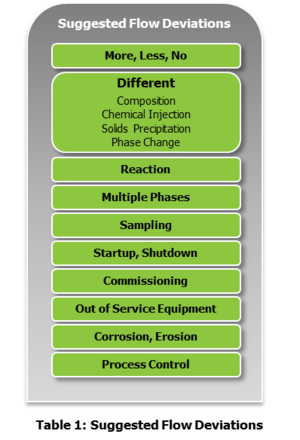What’s Wrong With HAZOPs & What We Can Do About It
A HAZOP is a team-based process hazard analysis (PHA) method. Its purpose is to identify hazards and operability issues in a process design. HAZOPs are not fun! Maybe that's not a problem, but they also don't achieve what they could and that is a problem.
WHY DON'T WE LEARN WHAT WE SHOULD FROM HAZOPS?
HAZOPs are not as effective as they should be for several reasons, including:
Tunnel Vision - The focus on small nodes obscures the big picture.
Guideword Excess - Flow, pressure, temperature, and level are not independent.
HAZOPs are supposed to identify operability issues, but they really don't explicitly address operability.
Risk assessment in HAZOPs is typically difficult, ambiguous and not repeatable.
HAZOP reports are difficult to read and are of limited use.
Most people don't enjoy HAZOPs and that impacts participation.
The GATE Stream-based HAZOP process avoids these pitfalls via some novel modifications to the process.
GUIDEWORD EXCESS
Figure 1 tells the story. Almost all causes of pressure, temperature and level deviation are caused by flow deviation. If you rigorously do all the flow, pressure, temperature and level deviation discussions you will perform the HAZOP twice. Often, the solution is to do the flow deviation discussions first and do the others by exception. That is problematic on a couple of levels.
When you get to ‘High Pressure’, there isn’t much to talk about and the record often says things like “See High Flow”. The conversation that we really need to have is almost an afterthought.
This messes up the HAZOP record. When ‘High Pressure’ scenarios are recorded under ‘High Flow’ the record is difficult to read and to use.
STREAM-BASED NODES & THE ‘FLOW’ DISCUSSIONS
Our solution to the guideword excess problem is to define a different kind of node for the flow deviation discussions, a stream-based node. For this purpose, a stream is a continuous flow of fluid across piping and equipment items. Any disturbance to the flow anywhere in the stream should impact the stream throughout (or at least at all points downstream of the disturbance).
Some streams are easy to identify. A 2,000 mile ethane pipeline with multiple pump stations is clearly one stream. Shut off flow at one point and it stops at all points.
Other streams are more abstract. Oil production from a well that flows through several separators where gas is flashed off and water is decanted can still be considered a ‘stream’ from the reservoir all the way to the Dry Oil Tank (Figure 2). The flashed gas and separated water also need to be considered as streams in separate stream-based nodes.
A stream-based node is ideal for discussion of flow deviations. The flow deviation discussion provides an opportunity to evaluate the operability of the system. The objective of most operating procedures is to establish or change the flow through a system. Operating procedures can be introduced at a high level. The flow deviation discussions can include discussions of startup (initiating flow), shutdown (stopping flow) and batch operations such as pigging. Commissioning can also be considered. See Table 1 for a more extensive list.
EQUIPMENT-BASED NODES FOR PRESSURE, TEMPERATURE & LEVEL DISCUSSIONS
The stream-based node is not an effective vehicle for discussion of pressure, temperature and level safeguarding. Equipment-based nodes (typical HAZOP nodes) are used to conduct the pressure, temperature and level discussion.
An equipment item will generally be part of more than one stream-based node. An equipment-based node is evaluated only after all relevant stream-based nodes have been discussed.
When we begin an equipment-based node discussion, we will have already identified almost all the causes of pressure, temperature and level deviation in that equipment item. We discuss the safeguarding for each node only one time and all the ‘High Pressure’ discussion for a node is contained at one place in the HAZOP record.
THE GATE STREAM-BASED HAZOP METHOD
The method described above is summarized below and in Figure 3.
Identify the stream-based nodes and develop a sketch of each stream-based node.
Identify the equipment-based nodes (typical HAZOP nodes).
For each stream-based node conduct the flow-deviation discussions. The purpose of the flow deviation discussions is largely to develop a detailed understanding of the process.
Where a flow deviation causes a temperature, pressure or level deviation, capture the cause in the appropriate equipment-based node. Delay discussion of frequency, consequences, and safeguards until the equipment-based node discussion.
Fully discuss other consequences of flow deviation (vibration, erosion, slugging, solids deposition, etc.).
For each equipment-based node conduct the pressure, temperature and level deviation discussions. This is done only after all stream-based nodes that include the equipment item have been discussed. Note that at this point almost all causes of pressure, temperature and level deviation will have been identified via the stream-based node discussions. The discussion now switches to discussion of frequency, consequences and safeguards. Safeguards are discussed only once considering the totality of identified deviations for the equipment-based node.
Evaluate risks and make recommendations
CONCLUSIONS
The HAZOP process is probably the most commonly applied process hazard analysis process. For a number of reasons, we do not learn as much as we should from HAZOPs. The GATE Stream-based HAZOP Method improves on some of the obvious shortcomings of the standard HAZOP process.
REFERENCES
Duhon, Sutton, (2010), “Why We Don’t Learn What We Should From HAZOPS”, SPE-120735-PA, SPE Projects, Facilities and Construction, June 2010
Duhon (2011), “Stream-based HAZOP, A More Effective HAZOP Method”, SPE-114982, Presented at SPE Americas E&P Health, Safety, Security and Environmental Conference, Houston, TX, USA, 21-23 March 2011
Duhon, Cronin (2015), “Risk Assessment in HAZOPs”, SPE-173544-MS, Presented at the SPE Americas E&P Health, Safety, Security and Environmental Conference, Denver, CO, USA, 16-18 March 2015
Duhon, “What’s Wrong with HAZOPs and What we can do About it”, presented at American Institute of Chemical Engineers 2015 Spring Meeting and 11th Global Congress on Process Safety, Austin, Texas, April 27-29, 2015




